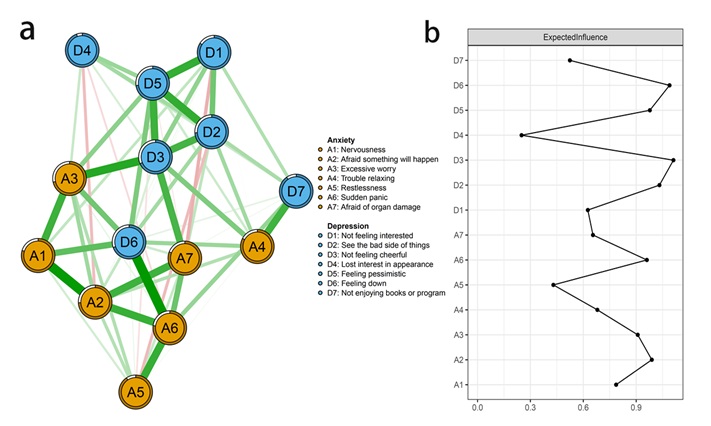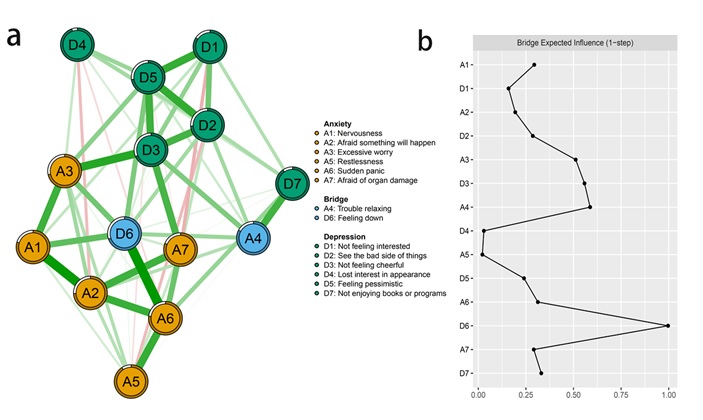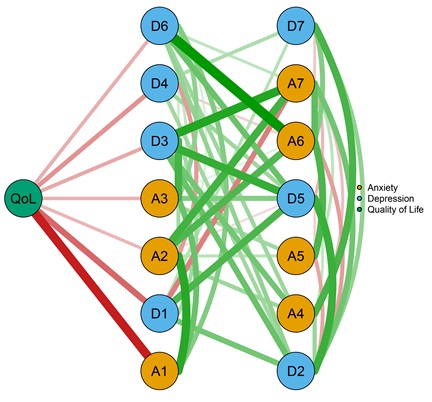Session Information
Date: Monday, November 13, 2023
Title: (1256–1263) Psychology/Social Science – Interprofessional Poster
Session Type: Poster Session B
Session Time: 9:00AM-11:00AM
Background/Purpose: Rheumatoid arthritis (RA) patients are susceptible to comorbid anxiety and depression. From the network model perspective, comorbidity is due to direct interactions between depression and anxiety symptoms. The objective of this study was to assess the network structure of depression and anxiety symptoms in Chinese RA patients and identify the central and bridge symptoms as well as how depression and anxiety symptoms are related to quality of life (QoL) in the network.
Methods: A total of 402 Chinese RA patients were included in this study. Depression and anxiety symptoms were measured by the Hospital Anxiety and Depression Scale (HADS).R software was used to estimate the network. Specifically, we computed the predictability, expected influence (EI) and bridge expected influence (BEI) for each symptom and showed a flow network of “QoL”.
Results: Our network revealed that the strongest edge was D2 “See the bad side of things”-D3 “Not feeling cheerful” across the whole network. For centrality indices, D3 “Not feeling cheerful” and D6 “Feeling down” had the highest EI values in the network, while A4 “Trouble relaxing” and D6 “Feeling down” had the highest BEI values of their respective community. As to “QoL”, the strongest direct edge related to it was A1 “Nervousness”.
Conclusion: Network analyses highlighted specific associations between symptoms of depression and anxiety in Chinese RA patients. D3 “Not feeling cheerful” and D6 “Feeling down” were the core symptoms in the network; A4 “Trouble relaxing” and D6 “Feeling down” were the most critical bridge symptoms. A1 “Nervousness” was also identified as key priority due to its significant association with QoL. Our study emphasizes the necessity of implications for clinical prevention and intervention based on these symptoms in Chinese RA patients.
The anxiety-depression network structure and the expected influence indices in Chinese RA patients. (a) The anxiety-depression network structure of the Chinese RA patients. The nodes in the network represent symptoms of anxiety and depression, and the edges represent correlations of symptoms. Green edges and red edges represent positive and negative correlations, respectively, and thicker edges represent higher correlations. (b) The expected influence indices in the anxiety-depression network of Chinese RA patients.
The anxiety-depression network structure highlighting the bridge symptoms and the bridge expected influence indices in Chinese RA patients. (a) The anxiety-depression network structure highlighting the bridge symptoms. The nodes in the network represent symptoms of anxiety and depression, and bridge symptoms are highlighted in blue. The edges represent correlations of symptoms, green edges and red edges represent positive and negative correlations, respectively, and thicker edges represent higher correlations. (b) The bridge expected influence indices in the anxiety-depression network of Chinese RA patients.
The flow network of quality of life in Chinese RA patients. The nodes in the network represent symptoms of anxiety and depression, and the edges represent correlations of symptoms. Green edges and red edges represent positive and negative correlations, respectively, and thicker edges represent higher correlations. A1-Nervousness, A2-Afraid something will happen, A3-Excessive worry, A4-Trouble relaxing, A5-Restlessness, A6-Sudden panic, A7-Afraid of organ damage, D1-Not feeling interested, D2-See the bad side of things, D3-Not feeling cheerful, D4-Lost interest in appearance, D5-Feeling pessimistic, D6-Feeling down, D7-Not enjoying books or programs, QoL-quality of life.
To cite this abstract in AMA style:
Lijuan Z, Beiwen W. Network Analysis of Depression and Anxiety Symptoms in Chinese Rheumatoid Arthritis Patients [abstract]. Arthritis Rheumatol. 2023; 75 (suppl 9). https://acrabstracts.org/abstract/network-analysis-of-depression-and-anxiety-symptoms-in-chinese-rheumatoid-arthritis-patients/. Accessed .« Back to ACR Convergence 2023
ACR Meeting Abstracts - https://acrabstracts.org/abstract/network-analysis-of-depression-and-anxiety-symptoms-in-chinese-rheumatoid-arthritis-patients/



